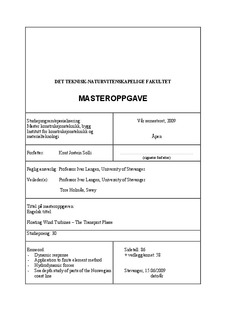| dc.contributor.author | Solli, Knut Jostein | |
| dc.date.accessioned | 2009-11-03T09:09:22Z | |
| dc.date.issued | 2008 | |
| dc.identifier.uri | http://hdl.handle.net/11250/182704 | |
| dc.description | Master's thesis in Structural engineering | en |
| dc.description.abstract | The worldwide demand of renewable energy is increasing rapidly because of the climate
problem. Wind energy appears as a clean and good solution to cope with a great part of this
energy demand. Therefore, floating wind turbines have been investigated as a possible
solution to increase the efficiency from the wind, as a renewable energy source. A critical
phase for the floating wind turbines is the transport phase. Economically, the floating wind
turbines should be transported in an upraised position and assembled from the construction
site to the actual offshore installation site.
Sway has been given generic data for a possible floating wind turbine. A finite element
program is developed in CALFEM for the wind turbine to detect the response from
hydrodynamic forces during tow out in upraised and assembled position. To introduce
hydrodynamic forces, liearized wave theory and Morison equation have been used. Due to
relatively large transport velocity, the relative difference between water particle velocity and
structural velocity will introduce hydrodynamic damping. This is a non linear problem and a
routine in CALFEM has been developed with theory for constant average acceleration. The
tower model has been built up with 2 dimensional dynamical beam elements.
Briefly summarized theory for harmonic response, hydrodynamics and Morison equation have
been given.
A suggestion of maximum transport conditions during tow out has been carried out. The
suggestion is based on the response analysis and parameters like different wave conditions
and different chain connections for the tow line are considered. Summarized, the suggested
maximum transport conditions are : - Maximum wave height: 5 meters, - Maximum transport velocity: 2.5m/s, - Chain support in node: 10 - 90 meters from the bottom of the tower. In addition, a sea depth study of parts of the Norwegian cost line is given, and maps have
been generated using “Norge Digitalt”. From this investigation we can see that because of the
many deep fjords that the Norwegian coast line has, it is fit to transport floating wind turbines
in upraised position. Also, huge areas in the ocean are available for floating wind turbines
farms in the future. | en |
| dc.format.extent | 2747112 bytes | |
| dc.format.mimetype | application/pdf | |
| dc.language.iso | eng | en |
| dc.publisher | University of Stavanger, Norway | en |
| dc.relation.ispartofseries | Masteroppgave/UIS-TN-IKM/2009 | en |
| dc.subject | byggkonstruksjoner | en |
| dc.subject | materialteknologi | en |
| dc.subject | dynamic response | en |
| dc.subject | application to finite element method | en |
| dc.subject | hydrodynamic forces | en |
| dc.subject | sea depth study | en |
| dc.subject | Norwegian coast | |
| dc.title | Floating wind turbines : the transport phase | en |
| dc.type | Master thesis | en |
| dc.subject.nsi | VDP::Technology: 500::Building technology: 530 | en |
